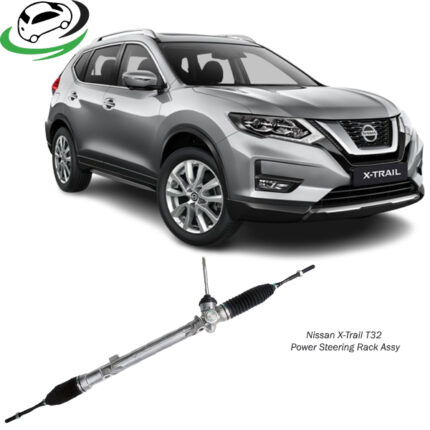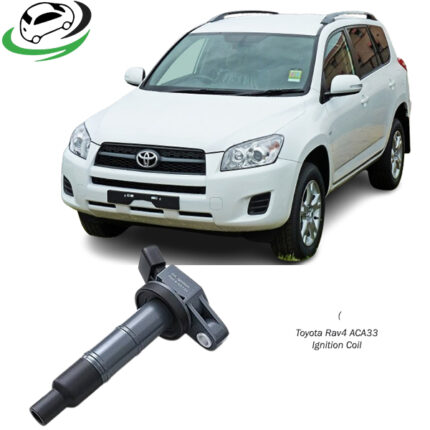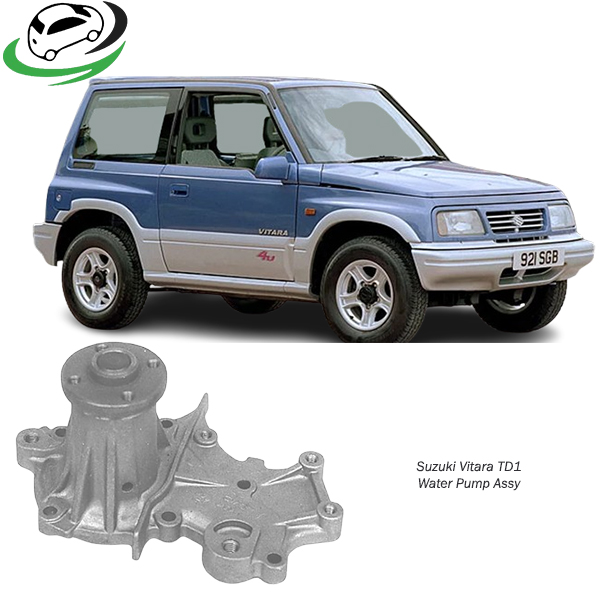-11%
Get Water Pump Assy Suzuki Vitara TD1 GWS-16A in Kenya
The water pump assembly is a mechanical device that propels coolant through the engine block, cylinder head, radiator, and heater core. This circulation is crucial for maintaining an appropriate thermal balance within the engine, preventing overheating, and ensuring the engine operates efficiently and safely.
Functionality
The primary role of the water pump is to create a continuous flow of coolant. As the engine runs, it generates substantial heat. The water pump drives the coolant from the radiator into the engine block, where it absorbs the heat produced during combustion. The heated coolant then flows back to the radiator, where it releases the heat into the atmosphere. This cycle repeats continuously while the engine is operating.
Components
Housing
The housing of the water pump is typically made of cast aluminum or iron. It encases the pump’s internal components and is designed to withstand the high temperatures and pressures within the cooling system.
Impeller
The impeller is a rotor-like component inside the pump housing. It has blades or vanes that spin when the engine runs, driven by a belt connected to the crankshaft. As the impeller spins, it creates a centrifugal force that pushes the coolant through the pump and into the engine.
Shaft and Bearings
The impeller is mounted on a shaft that rotates within the pump housing. Bearings support the shaft and allow it to spin smoothly. These bearings are crucial for the longevity of the pump, as they handle the rotational forces and prevent wobbling of the impeller.
Seal
A seal, usually a mechanical seal, is placed around the shaft to prevent coolant from leaking out of the pump housing. This seal must be robust, as any leakage can lead to a loss of coolant and eventual engine overheating.
Gaskets
Gaskets are used to seal the water pump to the engine block and prevent leaks. They are typically made from rubber or composite materials and ensure a tight fit between the mating surfaces.
Types
Mechanical Water Pumps
Mechanical water pumps are the most common type found in vehicles. They are driven by the engine’s crankshaft through a belt, chain, or gear. The speed of the pump is directly proportional to the engine speed.
Electric Water Pumps
Electric water pumps are becoming increasingly popular, especially in modern vehicles. They are powered by the vehicle’s electrical system and controlled by the engine control unit (ECU). Electric pumps offer several advantages, including more precise control of coolant flow and the ability to continue operating after the engine is turned off, which helps in cooling down the engine more effectively.
Auxiliary Water Pumps
Some vehicles, particularly those with turbocharged engines or complex cooling systems, use auxiliary water pumps. These pumps work alongside the primary water pump to provide additional cooling, especially during high-demand situations like towing or spirited driving.
Benefits of Water Pump Assy;
1. Engine Temperature Regulation
Prevention of Overheating
The primary function of the water pump assembly is to prevent the engine from overheating. By circulating coolant through the engine block, cylinder head, radiator, and heater core, the water pump ensures that excess heat generated during combustion is continuously removed.
Optimal Operating Temperature
Maintaining the engine at an optimal operating temperature ensures that all engine components function efficiently. Too high temperatures can lead to engine knock and pre-ignition, while too low temperatures can result in poor fuel combustion and higher emissions. The water pump helps in achieving and maintaining this balance.
2. Enhanced Engine Performance
Consistent Cooling
A well-functioning water pump provides consistent cooling, which is crucial for optimal engine performance. Consistent temperatures help in maintaining the correct clearance between engine components, such as pistons and cylinders, which can expand and contract with temperature changes.
Improved Combustion Efficiency
An engine running at optimal temperature burns fuel more efficiently. This leads to better fuel economy and reduced emissions. Efficient combustion also means more power and better throttle response, contributing to overall enhanced engine performance.
3. Longevity of Engine Components
Protection Against Thermal Stress
Consistent cooling provided by the water pump reduces thermal stress on engine components. This is particularly important for critical parts like the cylinder head, head gasket, and pistons, which can suffer from warping, cracking, or other forms of damage due to excessive heat.
Reduced Wear and Tear
By maintaining a stable operating temperature, the water pump minimizes the wear and tear on engine components. This extends the lifespan of parts such as the timing belt, head gasket, and other seals, reducing the frequency and cost of repairs.
4. Reliable Vehicle Operation
Prevention of Engine Failure
A functioning water pump is essential to prevent catastrophic engine failure due to overheating. Engine overheating can lead to severe damage such as blown head gaskets, warped cylinder heads, and even complete engine seizure. The water pump plays a critical role in preventing these issues.
Safety and Dependability
Reliable temperature control ensures that the vehicle can operate safely and dependably under various conditions, from daily commutes to long road trips. This reliability is crucial for driver confidence and vehicle dependability.
5. Efficiency and Fuel Economy
Optimized Fuel Usage
When an engine operates at its ideal temperature range, fuel combustion is more complete and efficient. This leads to better fuel economy as less fuel is wasted. Efficient fuel usage also translates to lower operational costs over the vehicle’s lifespan.
Reduced Emissions
Efficient combustion facilitated by a well-regulated cooling system helps in reducing harmful emissions. This is beneficial not only for the environment but also for compliance with stringent emission regulations.
6. Advanced Cooling Control with Electric Water Pumps
Precision Cooling
Electric water pumps, controlled by the vehicle’s ECU, offer precise control over coolant flow. This allows for more efficient cooling, especially during varying engine loads and speeds. Precision cooling can help in optimizing engine performance and fuel economy further.
Continued Cooling After Engine Shutdown
Electric water pumps can continue to operate even after the engine is turned off. This feature helps in reducing engine temperatures more effectively after a drive, preventing heat soak and further protecting the engine components.
7. Contribution to Comfort and Ancillary Systems
Cabin Heating
The water pump also plays a role in the vehicle’s heating system. By circulating hot coolant through the heater core, it enables the heating of the vehicle’s cabin, providing comfort to the occupants during cold weather.
Auxiliary Cooling Systems
In some high-performance and luxury vehicles, water pumps are part of auxiliary cooling systems that manage the temperature of turbochargers, transmission oil, and other components. This ensures that these systems operate within their optimal temperature ranges, enhancing overall vehicle performance and reliability.
8. Enhanced Engine Management Systems
Integration with Modern Engine Control Units
Modern vehicles equipped with electric water pumps benefit from their integration with engine control units (ECUs). This integration allows for smarter cooling strategies based on real-time data from various sensors, optimizing engine performance, fuel efficiency, and emissions.
Adaptive Cooling Strategies
Electric water pumps enable adaptive cooling strategies where the flow rate of coolant can be varied according to the engine’s needs. This flexibility is particularly beneficial in modern engines that need to balance performance, efficiency, and emission control.
Maintenance and Common Issues
Regular Inspection
Regular inspection of the water pump is essential for maintaining the cooling system’s efficiency. Look for signs of leakage, corrosion, or damage to the pump housing and impeller.
Coolant Leaks
One of the most common issues with water pumps is coolant leakage. This can be caused by a failed seal, worn-out gaskets, or cracks in the housing. Regularly check for coolant puddles under the vehicle or around the pump area.
Noise
A failing water pump often produces a high-pitched whining or grinding noise. This is usually due to worn-out bearings. If you hear such noises, it is crucial to replace the pump immediately to avoid further damage.
Overheating
If the engine is overheating, it could be due to a malfunctioning water pump. This might be caused by a broken impeller, a slipping belt, or a blockage in the cooling system.
Preventative Maintenance
To prevent water pump failure, it is advisable to replace the water pump, timing belt, and other related components according to the manufacturer’s recommended maintenance schedule. Using the correct type and mixture of coolant is also essential, as the wrong coolant can cause corrosion and reduce the efficiency of the cooling system.
Installation and Replacement
Removal
Replacing a water pump involves several steps. First, drain the coolant from the radiator and remove any components obstructing access to the pump, such as the timing belt or serpentine belt. Carefully unbolt the pump from the engine block, taking care to note the placement of each bolt.
Installation
Clean the mounting surface on the engine block and apply a new gasket or sealant to ensure a proper seal. Install the new pump, securing it with bolts in the correct sequence to prevent warping. Reattach any removed components and refill the cooling system with fresh coolant.
Testing
After installation, it is crucial to test the cooling system for leaks and proper operation. Start the engine and allow it to reach operating temperature, checking for leaks around the water pump and ensuring that the coolant circulates correctly through the system.
Follow us on Facebook for more parts.



